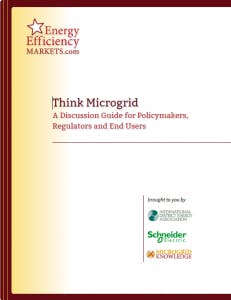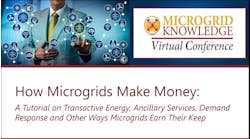This is the first in a series of articles from our new “Think Microgrid” special report.
Microgrids have been around for decades; in fact, configurations that look much like microgrids go back to Thomas Edison’s time. But for most of their history, microgrids operated as a niche technology, workable and financially feasible mostly on college campuses or in remote locations.
Now, the technology has radically ‘changed its stars,’ so to speak. Microgrids are poised to become an integral part of North America’s energy transformation.
Why now?
There is no one reason, alone, for the growing interest in these mini versions of the larger grid. In researching “Think Microgrid,” we found that it is instead a coming together of several societal, market and technological trends and changes.
First, cities and states see microgrids as a lever to spur economic growth. Today’s economy – technology-intensive and information-centered – requires clean, efficient, economic, highly reliable and locally controlled power and thermal energy. Microgrids offer this kind of premium energy. So their presence attracts high tech businesses, data centers, research centers, and similar industries that create sought-after jobs – and for whom energy security and business continuity are critical success factors.
“With microgrids we can develop reliability or resiliency zones that will be attractive for greenfield/brownfield projects and eco parks.” – Philip Barton, Microgrid and Reliability Program Director, Schneider Electric
Second, certain energy market trends favor microgrids, Natural gas and solar prices – two common fuels for microgrids – have fallen dramatically in recent years. Lower fuel prices make microgrids increasingly cost-effective to operate. Prices also are declining for electric energy storage, allowing for more effective use of solar energy in microgrids.
Third, new smart grid technology allows microgrids to perform in an increasingly sophisticated manner. Real-time data displays, grid interfaces, and various software advances allow microgrids to maximize their use and timing of resources for greatest economy.
Fourth, industry and government officials are very worried about grid reliability and security. Microgrids can keep the power flowing when the central grid faces threats.
Superstorm Sandy – and the expectation of similar storms ahead – intensely drives today’s interest in microgrid development. State leaders, particularly in the Northeast, are seeking ways to make the electric grid more storm hardy. And mayors and other local officials want more control over electric supply in a crisis. After all, they are often held accountable by the electorate when the grid is down. Yet in truth, they have little influence in an age when utilities are no longer home-town operations, and instead are likely to be owned by large national or international energy companies.
“People want local generation because of the increasing frequency and severity of extreme weather – wind, flood, mudslides, fire, hurricane and storm surges – and they want a better approach to anticipate and deal with the business disruption costs.” – Rob Thornton, President and CEO of the International District Energy Association
Storms are one threat to the grid; another is physical and cyber terrorism.
The Wall Street Journal recently published findings from a Federal Energy Regulatory Commission report that showed an assault on just nine key substations (out of 55,000) could cripple the US power system for weeks or possibly months. This occurred after unknown assailants shot out 17 transformers April 16, 2013 in Silicon Valley in a coordinated, night-time attack that included cutting telephone wires in the area, presumably to block 911 calls.
Perhaps more troubling, the US electric grid finds itself under almost constant cyber-attack, according to several recent state and federal reports. So far, we have warded off the danger, but the attackers are constantly changing their strategies. As Connecticut’s Public Utilities Regulatory Commission said in its recent report, “Cybersecurity and Connecticut’s Public Utilities:”
Hostile probes and penetrations of utilities occur frequently. Defenses in Connecticut so far have been adequate, but security challenges are constantly evolving and becoming more sophisticated and nefarious.
So, microgrids have become an important part of the plan to create a more resilient, secure energy system, one that can withstand the attacks of wind and water or hackers and terrorists. Should the central grid go down, microgrids can quickly “island” – disconnect to provide a continuous energy supply and protect their customers from the damage occurring on the larger grid.
Microgrids also are an environmental play, in an era when society increasingly demands clean and efficient energy. When anchored by combined heat and power and district energy, microgrids ward off energy waste and cut regional greenhouse gas emissions. Because they produce generation close to load, they avert line losses and can provide very valuable capacity services to support local or even regional grids. In addition, with appropriate scale and integrative technologies like thermal storage, microgrids provide balancing capacity to support intermittent resources like solar and wind.
And finally, microgrids offer a way to build new resources without evoking today’s all-to-common protests, the not-in-my-backyard phenomenon. Energy providers find it increasingly difficult to site high voltage transmission or large power plants because of local opposition. Microgrids, on the other hand, are generally small, un-intrusive and embraced by communities as a form of clean, local energy.
Benefits for End Users and Society
There are two ways to think about the advantages of microgrids. They benefit both their hosts, and society as a whole.
For end users, microgrids:
- Provide secure, reliable energy
- Earn revenue and reduce energy costs through buying and selling into sophisticated real-time wholesale energy markets
- Deliver high quality power and thermal energy, which is especially important to data centers, life sciences, e-commerce, pharmaceutical companies and similar tech-driven operations
- Customize energy operations to the distinct needs of the host
- Offer a way to produce and control energy supply locally
- Help businesses and institutions enhance their environmental reputation
Microgrids also can strengthen the central grid and reduce costs for everyone – even those not directly served by a microgrid. For society as a whole, microgrids can:
- Avoid the need for expensive upgrades and new infrastructure for the central grid
- Enhance efficiency and decrease costs by reducing line loss
- Enhance efficiency and cut emissions by using combined heat and power and district energy
- Provide services to the grid to balance load and stabilize frequency and voltage
- Reduce costly grid congestion
- Lessen strain on the central grid though load shedding when demand is high and wholesale power costs rise, such as a hot summer day
- Ease energy supply constraints, such as natural gas shortages in New England during cold snaps
- Serve as a source of power capacity to the central grid
- Increase the value proposition of solar and wind energy through use of energy storage
- Spur greater use of alternative energy technologies, such as fuel cells,
- Offer a new source of demand for America’s vast natural gas supply
What Could Hinder Microgrids?
Given their many benefits, microgrids are poised for expansion in the US, particularly in the Northeast and California. But how quickly the expansion occurs depends on the disposition of policy and regulation.
Policymakers, regulators and grid operators are just beginning to consider the rules that will govern the next phase of microgrid development and operation. Many states have yet to even define the term ‘microgrid.’
Therefore, the microgrid industry finds itself in a nascent and crucial stage. The outcome will determine how easy – or difficult – it will be for microgrids to position themselves in the marketplace. Ease of siting, franchise access, interconnection, regulatory approvals and financing depend on the outcome of proceedings just beginning in many states.
Crucial questions have yet to be answered, such as:
- How will microgrids be compensated for their services?
- Will they threaten the established utility business model, or serve as an operational ally and perhaps even a utility asset?
- Who will develop, own and operate microgrids in restructured states?
- How will regulators measure and monetize the environmental benefits of microgrids?
All of these issues are under debate within a highly competitive energy policy arena. The way forward could be difficult if established players perceive microgrids only as a competitive threat and work against them in regulatory forums.
So, while microgrids are in demand – and in fact announcements of new projects are more and more frequent – much work lies ahead to ensure fair policy.
This is the first article in a series from Think Microgrid: A Discussion Guide for Policymakers, Regulators and End Users.
Topics covered in this series are:
- Think Microgrid: How the Technology Has Changed its Stars
- So What is a Microgrid, Exactly?
- Growth and Economics of Microgrid
- Regulatory Landscape & Risk
- Regulatory Landscape & Risk Part 2
- How Policy Leaders Can Help Microgrid Achieve its Full Potential
- Case Studies 1
- Case Studies 2
Come back next week for the second article in this series, or immediately download the full report, free of charge: Think Microgrid: A Discussion Guide for Policymakers, Regulators and End Users, courtesy of the report’s underwriters: the International District Energy Association, Schneider Electric and Microgrid Knowledge







